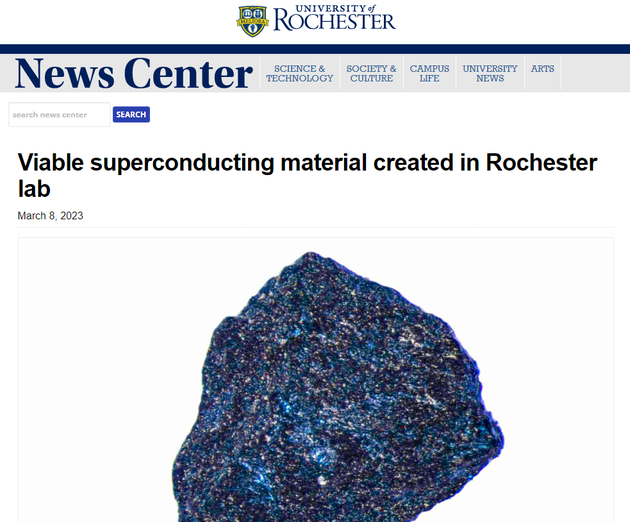At the recent American Physical Society meeting held in Las Vegas, physicist Ranga Dias and his team from the University of Rochester announced that they had developed a material made of hydrogen, nitrogen and the rare-earth metal lutetium achieves superconductivity at a room temperature of about 21 degrees under just 1GPa.
In a previous interview, Ranga Dias told National Business Daily that he and his team see this technology as a technology that will reshape the 21st century, but also pointed out that there are several years of hard work ahead to bring this discovery to real-world applications on any scale.

Photo/Screenshot at the official website of the University of Rochester
However, on March 15th, just eight days after the announcement of the world-shaking research, Wen Haihu's team with Nanjing University submitted a 16-page research paper co-authored by nine people to the preprint website arXiv, bluntly subverting Dias' research after replicating the experiment.
The experiment was not an exact replica. Wen Haihu found that the sample preparation plan given by Dias was almost unworkable, so they obtained the nitrogen doped lutetium hydride with a structure claimed to be the same as Dias' sample. The energy dispersive X-ray spectroscopy (EDS) confirmed the existence of nitrogen in some areas of the samples.

Wen Haihu (Photo/Official website of Nanjing University)
At ambient pressure, Wen Haihu's team witnessed a kink of resistivity and magnetization at about 300 K, which may correspond to a rearrangement of hydrogen/nitrogen atoms, namely a structural transition. However, by applying a pressure from 1 GPa to 6 GPa, the team saw a progressively optimized metallic behavior without showing superconductivity down to 10 K. Temperature dependence of magnetization shows a roughly flat feature between 100 and 320 K, and the magnetization increases with magnetic field at 100 K, all these are not expected for superconductivity at 100 K.
Thus, they concluded the absence of near-ambient superconductivity in this nitrogen-doped lutetium hydride under pressures below 6 GPa.
Wen Haihu said that these findings were sufficient to overturn Dias' research of room-temperature superconductivity at low pressure.
The rigorous team is still doing experiment to see still whether the material would exhibit high-temperature superconductivity at over 10GPa.
In fact, before Wen Haihu's team, research teams led by researcher Jin Changqing and researcher Cheng Jinguang from the Institute of Physics of the Chinese Academy of Sciences had successively published results of experiments on the compounds on preprint websites without finding any signs of superconductivity.


 川公网安备 51019002001991号
川公网安备 51019002001991号





